In this article, we’ll cover everything you need to know about rosy red minnows. These are a species of fish that are popular for both beginner and experienced fishkeepers. We’ll discuss their ideal habitat, care requirements, breeding habits, and compatibility with other fish.
Additionally, we’ll explain the significance of these fish in biological control and their availability in the aquarium trade. Whether you’re considering keeping rosy red minnows or just curious about them, this article provides a comprehensive guide.
Table of Contents
Rosy Red Minnows: A Quick Summary
Rosy red minnows are small, freshwater fish native to North America. They are known for their bright pink or red coloration and are popular among aquarium hobbyists. They are easy to care for and can tolerate a wide range of water conditions.
Rosy Red Minnow Overview
The Rosy Red Minnow is a popular freshwater fish often used as a feeder fish. It is known for its bright red coloration and small size, making it suitable for small aquariums. They are relatively easy to care for and can adapt to a variety of water conditions.
The Pimephales Promelas or the Rosy Red Minnow (sometimes also referred to as the fathead minnow), is a species of temperate freshwater fish that belongs to the Pimephales genus of the Cyprinid family. The rosy red minnow is basically a color variant of the fathead minnow that has its origin in North America. They are also found as far from there as Chihuahua, Mexico, Louisiana, and Great Slave Lake in Canada. This minnow has also been introduced to many other areas via bait bucket releases.
A mutant of the fathead minnow – the rosy red minnow was developed because it is more visible. It is a xanthic, golden strain of the fathead minnow. It is often sold as bait and in an aquarium, stores to be used as “feeder fish.”
Rosy red minnows are often called tuffies when sold as “feeder fish.” By some accounts, they are the most popular baitfish in the USA. They are wonderful fish, however, to keep in aquariums and ponds. They are best known for producing a type of distress signal known as Shreckstoff. In this article, we will learn about the rosy red minnow and the definitive guide to caring for it.
| Information Chart | Rosy Red Minnow |
| Scientific Name: | Pimephales Promelas |
| Family: | Cyprinidae |
| Care Level: | Very Easy |
| Temperament: | Peaceful |
| Color: | Orange, Pink, or Golden |
| Lifespan: | 2 to 4 years |
| Size: | 2 to 3 inches ( 5 to 7.5 cm ) |
| Diet: | Omnivorous |
| Minimum Tank Size: | 5 gallons but 10 gallons is recommended |
| Temperature: | 32 to 100 degrees Fahrenheit ( 0 to 37 degrees centigrade ) |
| Water Conditions: | PH of 6-8 and Soft to Very Hard |
| Tank Mate Compatibility | Peaceful community |
| Preferred Tank Set-Up | Freshwater with caves and rocks |
| Habitat | They can adapt to almost any condition, hence their nickname ‘ tuffies ’ (from tough) |
Rosy Red Minnow Appearance

As you have read earlier in this article, the rosy red minnow is a mutated variant of the fathead minnow that has its origins in North America. This variety of the fathead minnow usually boasts a pink, golden, or orange-colored body even though they have the color ‘red’ in their very name. Other prominent physical features of the fish include a short, dorsally flattened head, a long and slender body, round lateral eyes, a terminal mouth, almost translucent fins, and a blunt snout.
Their fins are typically translucent and streamlined. The dorsal fins are short and trim as well as their anal fins. They have a forked caudal fin that’s roughly the same height as the thickest part of their body from top to bottom. The caudal peduncle is colored and extends into the fin ever so slightly. The red minnow has 8 rays on its dorsal fins, 8 rays on its pelvic fins, 7 rays on its anal fins, and 15 or 16 rays on its pectoral fins. Its incomplete lateral line has 42 to 48 scales.
The key factor that helps distinguish the rosy red minnow from a regular fathead minnow apart from the obvious color difference is the absence of a stripe on its side. The red minnows have a body shape like that of a torpedo, which gives them the ability to swim relatively quickly.
The lifespan of a Rosy Red Minnow
Rosy red minnows typically live for a period of two to four years in captivity.
The red minnows usually live for about 2 years but they can potentially live double that amount if they haven’t spawned.
Size of a Rosy Red Minnow
A regular rosy red minnow will typically grow up to a size that ranges between 2 to 3 inches ( 5 to 7.5 inches ) over its life.
The size of these red minnows typically varies between 2 to 4 inches ( 5 to 10 centimeters) for an adult male while females are a little bit smaller. There have however been reported cases of these fish exceeding this general size while being kept in captivity. In all these situations, the fish were well taken care of and kept in schools while also being provided with ample room to swim in.
Natural Habitat and Origin
Rosy red minnows usually like living in lakes, rivers, and small ponds when they are in nature. They are extremely robust fish that have the ability to survive in rough and challenging environments. Coincidentally, this is where they have received the nickname they have been christened with – ‘ Tuffies ’. This nickname has been derived from the word tough. This helps them greatly as it prevents other predators from eating them.
Examples of them braving the toughness of the environment is their ability to tolerate the wide range of pH in water. They can survive in soft water having a pH of 6 and also manage to survive in very hard water with a pH of 8. The rosy red minnow is also known to be able to survive in places with high contents of salt and low oxygen content.
Not just the range in quality of water, but also the variation of temperature that the rosy red minnow has managed to grow in is commendable. These tuffies have been known to survive and grow in nearly freezing temperatures at 0 degrees centigrade ( 32 degrees Fahrenheit ) as well as a toasty 37 degrees centigrade ( almost 100 degrees Fahrenheit ). However, they are at their most comfortable and at their optimal breeding condition within the temperature range between 10 and 21 degrees centigrade ( 50 to 70 degrees Fahrenheit ).
The rosy red minnow is one of the easiest fish species to take care of. This is all thanks to the robustness of the fish and its uncanny ability to adapt to a very wide range of environments and changes. In high density and low oxygen conditions where even tropical fish wouldn’t survive, the red minnow will still prevail.
A trait that the rosy red minnow possesses is the fact that it has a unique way of sending a distress signal to other fish in the vicinity. If a red minnow is attacked or injured by a predator, the fish will release a certain chemical that oozes out of its skin. This chemical triggers the olfactory sense ( the sense which detects smell ) of other fish in the vicinity and serves as a warning to them to stay aware as there may be danger present around that area.
This defense mechanism was first observed in the year 1936 by an Austrian ethologist by the name of Karl von Frisch. He named this particular chemical ‘ Schreckstoff ’. ‘ Schreckstoff ’ literally translates to ‘ scare substance ’. The ethologist Karl von Frisch was able to prove through observation and studying that other minnows avoided the area that had the scare substance prevalent around it.
The rosy red minnow has its origins in the United States of America and Canada. However, today they can be found all over the globe. Leading experts believe that the main cause for their widespread popularity is a direct relation to their increased popularity in usage as bait.
Rosy Red Minnow Care & Tank Set-Up
Rosy Red Minnows, small freshwater fish native to North America, are ideal for both novice and experienced aquarium enthusiasts due to their easy care and adaptability to varied water conditions. They require a minimum 5-gallon tank, preferably 10 gallons, and thrive in a range of temperatures and pH levels.
These peaceful, sociable fish have a lifespan of 2-4 years and grow up to 2-3 inches, favoring a diet of omnivorous food with occasional plant-based items. Their breeding is straightforward, making them suitable for small home aquariums or ponds.
Rosy Red Minnow Tank Size and Specifications
Optimum tank size for Rosy Red Minnow
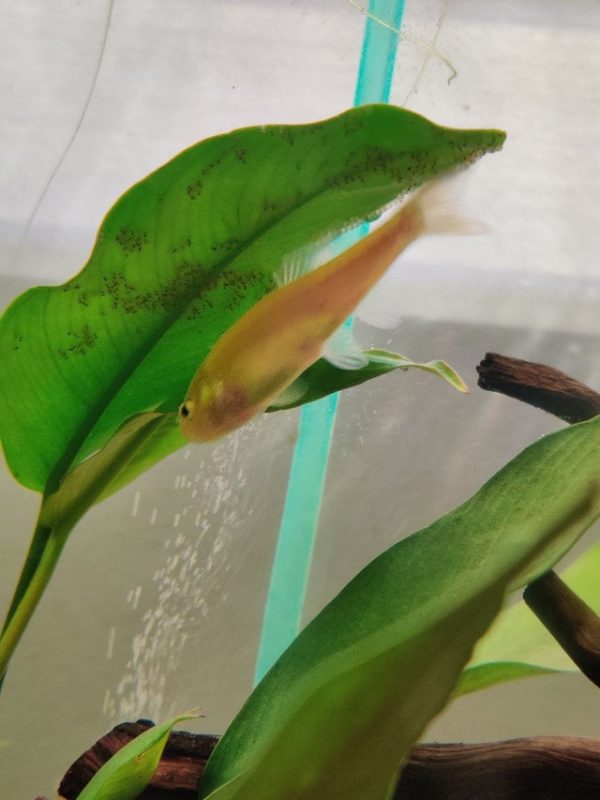
The recommended tank size for red minnows is 20 inches long, 10 inches wide, and 12 inches tall.
The absolute minimum size for a tank that is meant to house red minnows should be able to hold 5 gallons of water. However, the recommended size of the tank is one that can hold at least 10 gallons of water ( this quantity is taken into account assuming you have a school of 5 to 6 fish ). We suggest a larger tank as it will allow you to keep your options open to increase the number of fish you can keep while also making a big difference to the quality of life for the fish.
Tank type for Rosy Red Minnow
Plastic fish ponds, pond liners, and large tubs may be used to house the Rosy Red Minnow. Glass terrariums and even small children’s pools are good enclosures. A pre-formed pond can also be considered, keeping in mind their growing potential.
Filter type
For the rosy red minnows, a simple hang on the back filter ( HOB Filter ) or a simple sponge filter is sufficient to keep the tank clean and well filtered. This is a credit to the fact that red minnows are generally a very clean species of fish and do not cause a mess. Most filters are usually adequate for these fish.
Substrate
A classic gravel substrate is always a good choice, but you can do with something soft and sandy if needed too. Our suggestion would be to see what the other fish in the tank are comfortable with. The substrate that they prefer should generally be okay with the red minnows.
How many Rosy Red Minnows can you keep in a 10-gallon tank?
Ideally, no more than 5 or 6 rosy red minnows should be placed in a tank that can hold 10 gallons of water.
Water Parameters for Rosy Red Minnows
Water Temperature
The ideal water temperature for the rosy red minnow is between 10 and 21 degrees centigrade ( 50 to 70 degrees Fahrenheit ).
The red minnow is a very tough fish as mentioned above and can survive in temperatures ranging from near freezing ( 0 degrees centigrade or 32 degrees Fahrenheit ) to a warm 37 degrees centigrade ( around 100 degrees Fahrenheit ). However, the ideal temperature where the red minnow is most comfortable and can breed is between 10 and 21 degrees centigrade ( 50 to 70 degrees Fahrenheit ).
pH Level
The perfect water pH level for the rosy red minnow is between 7 to 8.
As mentioned earlier, the red minnow is a very robust fish and can adapt to a wide range of conditions. It can survive in water with pH levels ranging from 6 to 8 but it is recommended to maintain the pH levels of the water between 7 and 8.
Water Hardness
The rosy red minnow can survive in water that is Mildly soft to very hard. It can deal with variation just like with other factors, but the recommended quality shouldn’t be tampered with beyond the limit.
Rosy Red Minnow Tank Landscape
The interior set-up of the tank for the red minnow is not too specific. Here, you can be as creative and imaginative as you would like as there are no specific needs for these fish. Our suggestion would be to go ahead with the regular, basic decorations that are available. Best to keep it all simple.
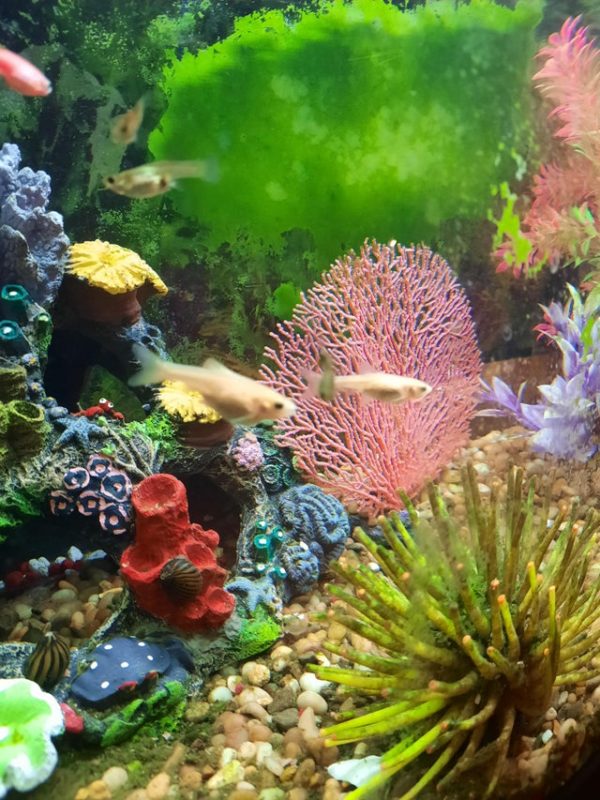
Best Plants and worst for Rosy Red Minnow Tanks
There are loads of plants you could choose to place inside ( hornwort or water wisteria are great options ) and if it pleases you, a few floating aquarium plants are also a good idea. Just remember not to put in too many plants because they are small fish and keeping track of them could get difficult.
Best Decorations for Rosy Red Minnow Tanks
Rocks, driftwood, and caves are also very suitable for these fish. However, you should keep in mind not to go overboard with all this as the red minnow likes to have space to swim. Moreover, if you have a small tank, then fitting in all these decorations will be quite difficult.
Best Lighting for Rosy Red Minnow Tanks
The red minnows prefer subdued lighting and therefore are not in need of intense light in particular.
Feeding the Rosy Red Minnows
The best diet for Rosy Red Minnows
After years of observation, it has been deduced by scientists that the red minnows are omnivorous fish. They eat plant matter, algae, insect larvae, and small invertebrates. However, when kept in home aquariums, they appear to gravitate more towards plant-based food. The best food for your rosy red minnows is high-quality pellet food or spirulina flake.
Once in a while though, it is okay to feed the fish frozen brine shrimp, daphnia, and bloodworms. However, these foods should be given to them in very limited quantities and their main diet should be based on herbivorous fish foods. The fish’s diet can be supplemented by blanched vegetables like shelled peas, cucumber medallions, zucchini medallions, etc.
How often should you feed the Rosy Red Minnows?
You should ideally be feeding your minnows twice a day. No more and no less all while maintaining their diet in a healthy manner as stated earlier.
Rosy Red Minnow Behavior and Temperament
Are Rosy red minnows lone or societal in nature?
The red minnows are a very social breed of fish and are of a very calm and peaceful temperament. They enjoy living in small groups ( usually 4 to 6 ). They will rarely do anything away from the group no matter what’s going on in the tank. These fish are an active breed and can be seen spending time together in various areas of the tank. The only time that you may see aggression among these fish is when they are ready to breed. Males might challenge each other which may lead to a fight between the two. At this point, the males will start to develop fatty tissue and breed tubercles on the top of their heads.
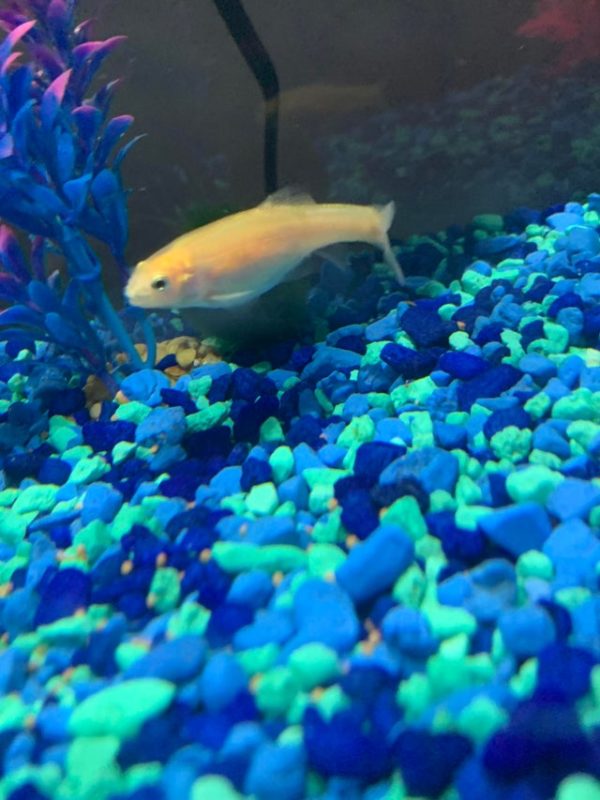
Rosy Red Minnow Tank Mates
Tankmates for your rosy red minnows can be chosen depending on your purpose of keeping the red minnows. If you intend to use them as feeder fish, you will house them with predator fish in which case they will not live too long. On the other hand, if you enjoy keeping them as pets, then the right tankmates for them will be peaceful, non – aggressive fish as listed below :
- Amano Shrimp
- Bristlenose Pleco
- Cherry Shrimp
- Dojo Loach
- Ghost Shrimp
- Hillstream Loach
- Mystery Snail (not for ponds)
- Various types Of Goldfish
- White cloud minnows
- Red shiners
Breeding Rosy Red Minnows
The first step in breeding your red minnows is identifying which ones among your fish are male and which ones are female.
The fish are mature once they reach roughly six months of age but will not be ready to breed until they are at least a year or two years old. At this point, they can be expected to spawn sometime between May and September. To promote the chances of breeding among the fish, try and keep the conditions optimal. Make sure the temperature of the water is kept between the ideal range of 32 to 100 degrees Fahrenheit ( 0 to 37 degrees centigrade ).
The female will then lay as many as 400 eggs in a single sitting, which will often be on a flat surface of some kind. The males then act as guardians for the next 4 to 5 days while they hatch to ensure they are safe while they fertilize. After these 4 to 5 days, these eggs hatch into the first fry. 2 or 3 days after this, the fries become active and you can feed them brine shrimp or infusoria.
Rosy Red Minnow breeding level – Very Easy
Rosy Red Minnow Sexual Dimorphism
The first telltale sign is that the males are slightly larger than the females. Another tip is that the male of the species has a dark head and will generally appear a bit darker in complexion. Also, males occasionally sport white/gold bars beneath the dorsal fin and behind the head. Similarly, the females will have brighter colors and slightly smaller heads.
Rosy Red Minnow: Common Diseases and their treatment
Rosy Red Minnows are prone to diseases like fin rot, pop-eye, scale loss and shedding, and backbone deformities. Fin rot involves fin degradation and color change. Pop-eye is caused by fluid build-up in or behind the eye. Scale loss can indicate infection or environmental stress, leading to further health issues.
Backbone deformities, often a result of genetic, nutritional, or environmental factors, manifest as abnormal spine bends. Treatment varies based on the specific disease and its underlying cause.
Fin rot
Fin rot is generally an easily spotted condition where the fins and tail of a fish become noticeably degraded. They may change colors, appear inflamed at the base, and be frayed or ragged. Fin degradation begins at the edges of the fin and works its way toward the base. Once the infection reaches the base the fish will not be able to regenerate new fin tissue, and the infection may spread to the body. Fin rot may be a symptom of disease, but this is not always the case.
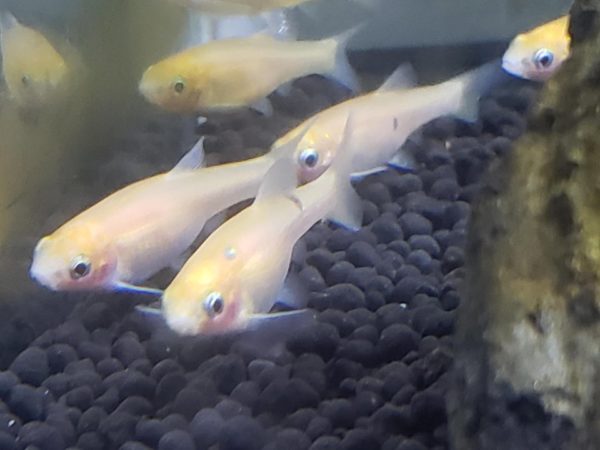
Pop-eye
Pop-eye is a common symptom that can result from several infections. This is another noticeable symptom. Pop-eye occurs when fluid builds up either behind the eye or in the eye. This causes bubbles in the skin surrounding the eye eventually causing the eye to bulge out of its socket. If not treated in a timely manner the fish can lose sight of the affected eye.
Scale loss and shedding
Small amounts of scale loss occur naturally. However, when large patches of scales are lost it can become a problem. This can be a sign of an existing infection where the tissue holding the scales has become degraded. It can also indicate an infection that causes the fish to rub against hard surfaces, causing patches of scale loss. Areas without scales can open the fish up for further infection. Also, be aware of areas with raised scales as this is most likely an early phase of scale shedding and can be an indicator of disease.
Backbone deformities
Backbone deformities are common in cultured fish. Typically the spine will bend abnormally, sometimes at an angle. Depending on the direction of the bend, this condition can be referred to as scoliosis, a horizontal bend, or lordosis a vertical bend. If developed during early life stages, the condition may be permanent. Backbone deformities have a number of causes; in cultured fish, it is commonly associated with a Vitamin C deficiency. In other cases, it can also be a genetic defect, the result of an injury, or a symptom of a bacterial infection.
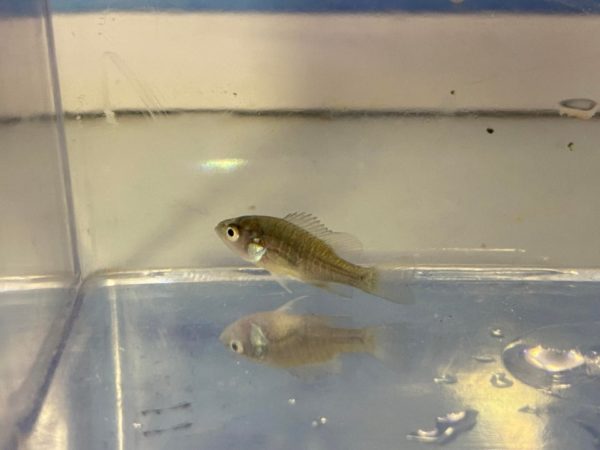
Facts about Rosy Red Minnows
- Rosy red minnows are typically 5 to 8 cm long and have a very compressed head and snout.
- They are golden or orange in color, with nearly translucent fins.
- Unlike other fathead minnows, the rosy red variety does not have a stripe down its side.
- Rosy red minnows are native to Canada and the United States, although they have been introduced to other regions because of their use as bait.
- The fish prefer to live in small ponds, rivers, and lakes.
- They can survive in environments that would be challenging for other freshwater fish, such as water with low oxygenation, variable pH, or high levels of silt. They do well with a wide range of water temperatures also.
- They are omnivorous
- When the male challenges another male, they develop fatty tissue on the top of their heads
Are Rosy Red Minnows right for you?
Regardless of whether you are a first-time fish owner or if you are a veteran fish collector and enthusiast, the rosy red minnow is one fish that you can absolutely never go wrong with. With the robustness of the red minnow and its adaptability, taking care of it takes minimal effort. Your initial expenditure on the fish is low along with the cost of setting up the aquarium or the fish tank. They also come in a variety of colors which can add a little bit of vibrance to your aquarium as well. They are also very easy to breed, making them a perfect addition in case you ever want more.
Frequently Asked Questions ( FAQ )
What do minnows eat?
Rosy Red Minnows are omnivorous fish and they eat a variety of foods. They eat plant-based foods along with the occasional brined shrimp or bloodworm.
How fast do rosy red minnows breed?
Rosy Red minnow eggs take up to five days to hatch. Each cluster has about 400 eggs that you might find on or in one of your aquarium structures.
Are rosy red minnows aggressive?
Absolutely not. Rosy red minnows are a very peaceful and social breed of fish.
Are rosy red minnows hardy?
Rosy red minnows are very hardy and can survive in a vast array of environmental conditions.
Do rosy red minnows need a heater?
The temperature in the tank needs to be kept to 50 – 78°F. Remember that the fish is highly adaptable and will still survive in temperature ranges outside of this that are recommended.
How many rosy red minnows can I put in a 10-gallon tank?
In a 10 gallon tank, there would ideally be a school of 4 to 6 red minnows.
Can we use Rosy red minnows as bait?
Yes, red minnows can be used as bait while fishing. In fact, it is one of the most popular fishes used as bait.
CONCLUSION
The rosy red minnow is what you might be able to call the perfect home fish. It is very easy to care for, can survive in a variety of environmental conditions, and is a minimal effort fish. Moreover, it has a very vibrant appearance and the way it darts around with such quickness around the aquarium is a guaranteed attraction at home. They can serve as great low-maintenance pets or can even come in handy as feeder fish when you take a weekend trip to the lake. They are also very easy to breed, making them a very desirable species of fish.
No related posts.
